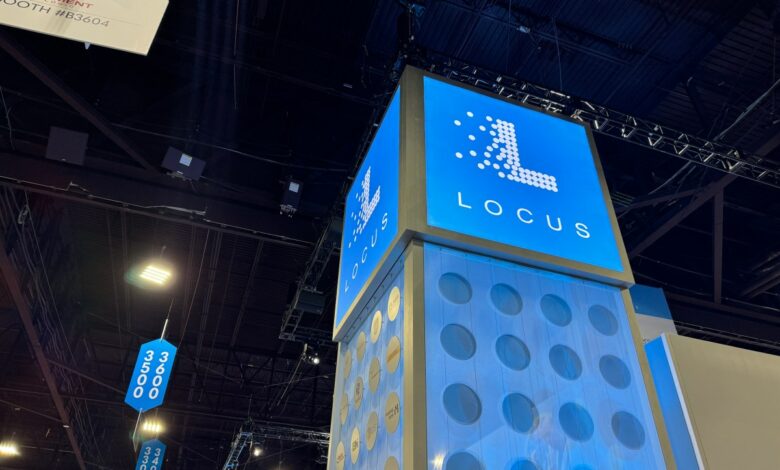Locus Robotics’ success is a tale of focusing on what works

“We’re fundamentally a software company,” Locus CEO Rick Faulk says with a laugh. We look like a robot company, but we’re actually a software company.”
It’s a familiar refrain from companies whose most public-facing products are hardware. That’s certainly the case with Locus, which produces the best-known AMRs (autonomous mobile robots) not made by Amazon. While it’s true that these tote-moving systems are fundamental to the Massachusetts-based firm’s warehouse play, Faulk tells TechCrunch that the company’s software is what really sets the market leader apartment from the competition.
Locus currently offers fleet management software, essential to orchestrating robotic systems in a busy setting. That’s also a feature of the company’s latest offering, LocusHub Engine. Announced this week at the Modex supply chain show in Atlanta, the platform is designed to leverage the data collection that’s foundational to the company’s automation system. Much like your Roomba at home, Locus’ AMRs are packed with sensors that bring situational awareness and help it navigate around people, obstacles and other robots.
At their heart, they’re data-collecting machines that are also quite good at moving heavy payloads around warehouse floors. The new software offering uses AI to process the massive troves of data collected and offer predictions for what’s coming next.
“Most reporting in warehouses right now is what we call ‘reactive,’” Faulk tells TechCrunch. “It’s what happened. Someone picked X number of units per hour, here’s how many you should pick for the day, week and month. We believe that’s great and we still need that, but we also believe in having predictive analytics to tell you what’s about to happen is incredibly important.”
Utilizing machine learning, predictive modeling offers suggestions for where warehouse managers should distribute staff — both human and robot. The software can also be used to identify bottlenecks and refine the AMRs’ routes for better efficiency.
“We have uniquely integrated data capture from our robots into our platform,” says Faulk. “For example, I can go into my phone and look at any single robot in our system. I can actually control that robot and update that robot over my phone. We have the capabilities to be able to integrate both of those together.”
Locus’ founding was a direct result of Amazon’s 2012 Kiva Systems acquisition. Quiet Logistics, a former Kiva client, was among those customers left in the lurch when the retail giant decided to stop servicing outside companies, instead focusing the whole of its efforts on automating its own fulfilment processes. Quiet began its own robotics division in 2014, spinning out Locus the following year.
The Kiva acquisition was a massive catalyst for the category at large. Former executives from the robotics startup launched their own Locus competitor, 6 River Systems. That company has struggled in recent years, however, following its acquisition by Shopify and subsequent sale to English grocery technology licenser Ocado Group. Another key competitor, Fetch Robotics, was founded in 2014. In 2021, the company was acquired by commerce tech giant Zebra. More recently, founder Melonee Wise left the company to join Agility’s growing executive team.
You can spot dozens of direct competitors walking through the halls of Modex this week, but Locus remains the market leader by a wide margin. It’s a position further cemented by the explosion of interest in warehouse automation spurred on by the pandemic. Investor activity was at an all-time high, fueling companies hoping to level the playing field in a world completely dominated by the 800-pound Amazon gorilla.
Investor excitement has since abated. While it’s true that plenty of operations are still having difficulty hiring human labor, there’s still a regression to the mean. This January, Locus laid off a small number of staffers — a figure the company has yet to disclose.
“We frankly over-hired on our go-to-markets, like a lot of our clients,” says Faulk. “We came out of COVID and had projections on staffing needs and that sort of thing that were probably overestimated.” The CEO adds that the “adjustments” happened among Locus’ go-to-market headcount, rather than the engineering team.
But the company remains a success story in the category more broadly. It’s managed a steady growth by focusing on existing client needs, rather than attempting to be all things to all people. A decade after its founding, tote-transporting AMRs are still at the center of everything Locus does. Over the years, the company has added products like Vector, which can port up to 600 pounds and features specialized wheels that allow it to effectively drift sideways to better navigate tight spaces. Each new robot is — in essence — an iteration of Locus’ core robot product.
At present, human labor is essential to that story. Locus does not produce a mobile manipulator, meaning people have to move totes onto and off of the robot. Asked whether Locus will be the company to bring that technology to the warehouse, Faulk responds, “We will. We’re looking at a number of things that will reduce labor in a building. We have an R & D group that is looking at things to fully automate a building. Over time, I’m sure we’ll figure it out.
Perhaps unsurprisingly, Faulk isn’t particularly bullish on the role humanoid robots will play in that future.
“Maybe for specific functions it might [be useful],” he explains. There are challenges today between battery life, cost, uptime and all the other things that go along with it. I think eventually there may be some use cases for specific things. But I think that’s years away before there’s any scale. There are tests that will be done, but before anything gets to enterprise scale, I think it will be years.”
Source link




